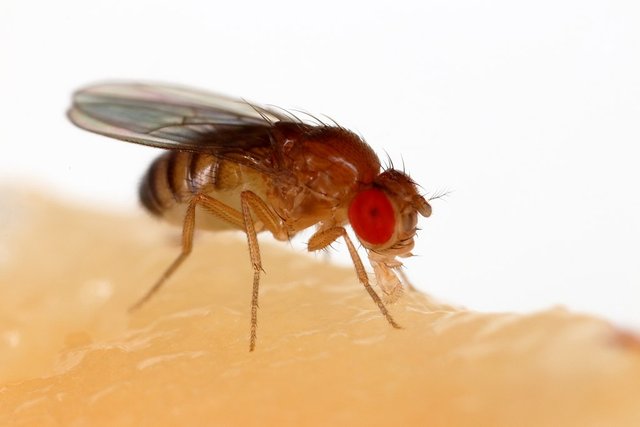Da Vinci Times #18.1
The brain of the fruit fly
The brain of Drosophila Melanogaster, commonly known as fruit fly, has been photographed with unprecedented resolution. In total, there are 21 million images taken at the brain, that show in detail the neuronal structures of this insect.

Imagine CC0 Creative Commons - Source
Electronic microscopes were used to map the 100,000 neurons that make up the fruit fly's brain. Heavy metals, which shield the electrons emitted by the microscope, have been injected into the gnat's brain. In this way it was possible to detect the points of greatest accumulation of these metals. This technique, combined with a high frame rate camera, allowed to obtain extremely precise images. Despite its simplicity, Drosophila Melanogaster is a model organism for studying the functioning of the brain. Such a sophisticated imaging technique will allow to discover new characteristics of the gnat's brain, and in the future it will certainly be applied to the most complex organisms.
The change in the Atlantic circulation
The slowing of the southern Atlantic currents is due to a natural cycle, and not because of the effects of global warming of anthropogenic origin. The study, conducted by American and Chinese researchers, has been published in Nature.

Imagine CC0 Creative Commons - Source
Ocean currents are essential to maintain the thermal balance of the planet, because they mix masses of hot and cold water and mitigate the temperatures in the areas where they are present. The current object of the study is the Atlantic-Southern current, which moves large masses of hot water towards the north and cold towards the south. This current has undergone a decrease of its activity in the past decades, making suspect that the reason for the weakening was the climate change of anthropic origin. New data show that, in reality, there is a natural cycle in which the activity of the current reaches a maximum and a minimum.
Memories of molds
For a long time we have discussed the possibility that some types of organism, which do not have a nervous system, are nevertheless characterized by the possibility of manifesting behaviors linked to memory and learning. However, not everybody consider the results obtained to be valid.

Imagine CC0 Creative Commons - Source
A group of French researchers has shown that they have somehow "educated" molds in recognizing and avoiding dangerous areas; the surprising aspect, however, was the ability of the mold cells to transmit the information to the new cells, as a sort of memory. It is not yet clear how this can actually be a learning process, but it is easy to imagine that the nervous system as we know it must have evolved from something more primordial, and this could be the way.
Post of the day

Imagine CC0 Creative Commons - Source
Hallucinations are something that we all know, at least roughly; but it is not so simple to discriminate between real hallucinations, illusions and false beliefs... And it is not easy even to identify which mechanisms, or what pathologies, cause them. @conficker tries to make some clarity.

Immagine CC0 Creative Commons, si ringrazia @mrazura per il logo ITASTEM.
CLICK HERE AND VOTE FOR DAVINCI.WITNESS
Keep in mind that for organizational reasons it’s necessary to use “steemstem” and “davinci-times” tags to be voted.
@viki.veg - @spaghettiscience - @rscalabrini
Il cervello del moscerino
Il cervello della Drosophila Melanogaster, comunemente noto come moscerino della frutta, è stato fotografato con una risoluzione senza precedenti. In totale sono 21 milioni le immagini scattate al cervello e mostrano nel dettaglio le strutture neuronali di questo insetto.

Imagine CC0 Creative Commons - Source
Per mappare i 100’000 neuroni di cui è fatto il cervello del moscerino sono stati utilizzati dei microscopi elettronici. Sono stati iniettati nel cervello del moscerino dei metalli pesanti, che schermano gli elettroni emessi dal microscopio. In questo modo è stato possibile rilevare i punti di maggior accumulazione di questi metalli. Questa tecnica, unita alla grande velocità di ripresa delle immagini, ha permesso di ottenerne di estremamente precise. Nonostante la sua semplicità, Drosophila Melanogaster è un organismo modello per studiare il funzionamento del cervello. Una tecnica di imaging così raffinata permetterà di scoprire nuove caratteristiche del cervello del moscerino e in futuro sarà certamente applicata agli organismi più complessi.
Il cambiamento della circolazione atlantica
Il rallentamento delle correnti atlantiche meridionali è dovuto a un ciclo naturale e non ad effetti dovuti al riscaldamento globale di origine antropica. Lo studio, condotto da ricercatori americani e cinesi, è stato pubblicato su Nature.

Imagine CC0 Creative Commons - Source
Le correnti oceaniche sono fondamentali per mantenere l’equilibrio termico del pianeta, perché rimescolano masse d’acqua calda e fredda e mitigano le temperature nelle zone in cui sono presenti. La corrente oggetto dello studio è quella atlantico-meridionale, che sposta grandi masse d’acqua calda verso nord e fredda verso sud. Questa corrente ha subito un decremento della sua attività nei decenni passati, facendo sospettare che il motivo dell’indebolimento fosse il cambiamento climatico di origine antropica. Nuovi dati mostrano che, in realtà, esiste un ciclo naturale in cui l’attività della corrente raggiunge un massimo e un minimo.
I ricordi delle muffe
Da molto tempo si discute riguardo la possibilità che alcuni tipi di organismi, non dotati di sistema nervoso, siano comunque caratterizzati dalla possibilità di manifestare comportamenti legati alla memoria e all’apprendimento. Non tutti però ritengono validi i risultati ottenuti.

Imagine CC0 Creative Commons - Source
Un gruppo di ricercatori francesi ha dimostrato di aver in qualche modo “istruito” delle muffe a riconoscere e ad evitare delle zone pericolose; l’aspetto sorprendente, però, è stata la capacità delle cellule della muffa di trasmettere le informazioni alle nuove cellule, come una sorta di ricordo. Non è ancora chiaro quanto questo possa effettivamente essere un processo di apprendimento, ma è facile immaginare che il sistema nervoso, per come lo conosciamo, debba essersi evoluto da qualcosa di più primordiale e questa, potrebbe essere la strada da seguire.
Post del giorno

Imagine CC0 Creative Commons - Source
Le allucinazioni sono qualcosa che, almeno a grandi linee, tutti conosciamo; eppure non è così semplice discriminare tra allucinazioni vere e proprie, illusioni e false convinzioni… E non è semplice neppure identificare quali meccanismi, o quali patologie, le causano. @conficker prova a fare un po’ di chiarezza.

Immagine CC0 Creative Commons, si ringrazia @mrazura per il logo ITASTEM.
CLICK HERE AND VOTE FOR DAVINCI.WITNESS
Si ricorda che per motivi organizzativi è necessario utilizzare le tag “steemstem” e “davinci-times” per essere votati.
@viki.veg - @spaghettiscience - @rscalabrini
This post has been voted on by the steemstem curation team and voting trail.
There is more to SteemSTEM than just writing posts, check here for some more tips on being a community member. You can also join our discord here to get to know the rest of the community!